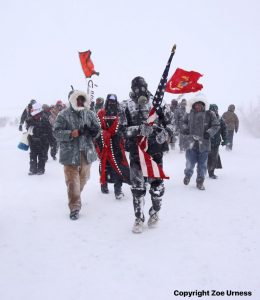The Standing Rock photograph, Dec. 6, 2015: No Spiritual Surrender, by Tlingit photographer Zoe Urness, has been entered for a Pulitzer Prize in Feature Photography by World Literature Today, where it appears as the cover of the magazine’s May 2017 issue, “New Native Writing: From Wounded Knee to Standing Rock.”

In an interview, Urness described how she arrived at Standing Rock and what drew her to the scene that would become the photograph.
“Standing Rock had become quite a movement, and I was actually at a booth at Indian Market and the protesters came through,” she said. “Then I started to follow along with everything that was happening in Standing Rock via social media and friends that had gone up there.
“You know, a lot of people just started to transition over there for however long they could stay. Some of them didn’t even leave until the end, but it wasn’t until the night that the water cannons went off where I had a knee-jerk reaction…. Tony Abeyta and I and another artist friend were just like, ‘Let’s go.’ And we had to go…. So, we loaded up, packed our stuff, and I hit REI and bought all-weather temperature things that I thought I would need, and we went off up there, and … the other artists had made gas masks and other protection gear, and we left it! Halfway up, we realized we’d left it. Going into this, we didn’t know what we were driving into up there and what we would face.”
The photograph captures a moment on the frigid, snowy day when veterans arrived to join the water protectors.
“That day happened where the thousands of vets showed up in support of the water protectors, and so I marched to the front lines during this protest where everyone had gathered and were going to the front, and it was really chaotic,” she said. “The temperature was dropping, a blizzard was hitting, and the camp had the most people that had been there at the camp thus far, under the most extreme conditions, and lots of elders were there as well … . A lot had come to support of all ages … and all races. That’s what I noticed too. Walking around camps you would hear different languages from all over and see people of all colors of the rainbow. And so it really was not a racial issue. It was a humanity issue, which I’d known before but that’s what I drive home now today. You even see that within the images that I collected up there … the representation of humanity up there.”
Urness said she was perched above the scene when she recognized a man wearing a red button blanket, which is the regalia of her own tribe.
“You can see the man wearing it,” she said. “It’s red and black with the mother of pearl buttons on it, and on the back of that robe you wear your clan, so I would have an eagle wolf on mine and when you dance into the longhouse traditionally in your holy ceremony or dance or celebration, you dance in the door backwards to show people as you’re entering where you’re from, by your clan. So that’s why when I saw that I recognized it. I’ve been participating and performing in my Tlingit dance group since I was four, and so that’s why it was so personal.”
She shot the photograph, and almost immediately she realized its power. Since then, the photograph has been published numerous times and has won several awards, including Best of Classification in Paintings, Drawings, Graphics, Photography (2-D Art) at the 2017 Heard Fair and Market. For more on the story of the photograph, see her bio in the FAAM-produced 2018 Heard Fair Guide.
While many of the people in the photograph have been recognized or come forward, the man in front has not.
“That one guy in the front with the mask? The flag he’s carrying, kind of the predominant figure in the foreground…. It’s interesting because a lot of people have come forward saying they can identify themselves, but this man has not identified himself,” she said. “I mean, I go to even a farmer’s market in Venice and someone will talk about the picture, and I’m like, ‘Oh, I took that.’ It’s interesting because it’s gotten around so virally that I’m wondering if someday I will figure out who the front figure is, if I can identify him. But also there is a strong belief in movements that you cover your face because you do it for the cause, not for individual recognition so maybe he’s just abiding by that philosophy.”
Kiowa author N. Scott Momaday was awarded the 1969 Pulitzer Prize for Fiction for his novel House Made of Dawn, but few Indigenous people have won Pulitzers in any category.
This year’s nominated finalists and winners will be announced on April 16, 2018.
To see more of Zoe Urness’s work, visit zoeurnessphoto.com.
